In 1922 in the State Tretiakov Gallery, Petr Petrovich Konchalovsky’s first personal exhibition is opened. There the drawings and canvases written during the time since 1907 till 1922 have been collected – it is the first public display of all creative way of the artist.
In 1922 the artist spends the summer near Moscow, in Krylatskoe village where he writes the next version of the «Female Bathers». In comparison with the similar work of the last year, the new approach to the decision of a problem of depicting a naked body in the nature is obvious. A landscape appears now the basic subject of a picture, and the human figure is not equal, but is subordinated to it – becomes its part.
The theme of “bathing” is continued with works: “In front of a Mirror”, “The Invalids bathing”.
An outstanding work of this time undoubtedly is “The Portrait of the Artist and his Wife”.
“This time I wanted not “to do” a subject, not to transfer the attributes of its “substantial being”, but “to write” it, to insert a subject into its environment in the picture. The composition was arranged with difficulty, especially the position of hands, and it took a long time until finely they were settled down similarly to an “eight”. By chance, my own face was written at once, but I was forced to work long on the image of my wife. As the entire portrait should have a uniform color decision, my wife had put on a special dress, made by my design: a black velvet corsage and sleeves of the color of bronze. The velvet was written in a complex composition of colors with many paints, up to Indian yellow. And in general I have worked a lot on processing the texture of this canvas, much more, than in “Agave”. There were the dangerous moments during the work: written before was almost spoiled, sometimes I was forced to drop the work, to doubt the future and my forces, my ability to master the problem… This portrait had taken much, too much! “
By Nikolsky -…1936 – p.87
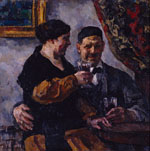
Self-Portrait with Wife. 1923
1923 the artist again lives in Krilatskoe, continues working on landscapes. There he creates the works “The Moon in the Branches”, “Dawn”, “The Night Landscape”, “Ravine”.
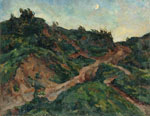
Ravines. 1923
This year Konchalovsky’s first genre works are created: “Harvest”, “The Reapers”, and “Harvesting”.
Thus, since creation of products of 1922-1923, it is possible to speak about the next turn in the painting of artist. His works now are closer to the realistic tradition in Russian painting. It is possible to speak about his final withdrawal from a cubism and “cezannism”. The sensation of the materiality, the reach color now is peculiar to the painting of artist.
Three cycles of works of the artist are concerning to the period since 1924 for 1927, those are: written during his trip to Italy in 1924, – in Novgorod in 1925-1926 and – at Caucasus in 1927.
At Venice Konchalovsky takes a great interest in creativity of Tintoretto and does many sketches of his pictures, writes eight etudes including “The House of Tintoretto”.
At Sorrento he writes a series of studies. “Vesuvius in the Morning”, “Vesuvius in the Evening”, “Vesuvius through the Trees”, “Vesuvius or an Olive Grove”.
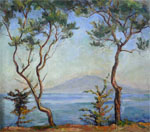
Sorrento. Vesuvius. Two Olives. 1924
On a declaration of the artist, during a trip across Italy he did not put the problems of analytical order but wrote being under the influence of nature.
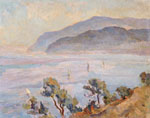
San-Angelo. The Sea. 1924
In March, 1925 Konchalovsky moves with the family from Italy to France, to Paris. The French modern painting pushes him to the decision to return to the analytical painting and to the searches of his own style.
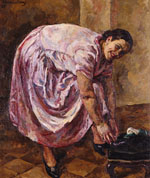
Portrait of N.P.Konchalovskaya. 1925
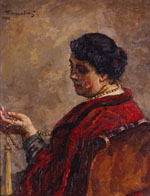
Portrait of O.V.Konchalovskaya. 1925
After returning to Russia the artist goes with the family to Novgorod Veliky. There he creates a new painting series. Three summers on end, master lives near Novgorod, and writes the Novgorod nature and architecture.
As well as in Siena, the artist again is guided by impressions, and direct emotions, absolutely forgetting about the decision to do analytical, “conscious” painting.
In 1926 Konchalovsky writes a great genre composition “Returning from the Fair”.
“In the «Returning from the Fair» I had a conception to impregnate with movement all: the sky with running clouds; the smooth surface of the lake cut around by sailing vessels; the running horses, and the movement of a cart. My desire to transfer real dynamics was so strong that, I even ran near a rushing cart to catch a notion how horse’s legs are settling onto the ground during the run. I have done a special etude of a shaft to seize its line more truly, though I have a good art memory. The theme grasped me so that I couldn’t help falling into absolutely unnecessary naturalism: I even tried to depict the dust from under the wheels for example, where I had only to take the wheels in the essence of their movement that the spectator could see how they are raising the dust. In the real painting, as well as in any real art, there always should be an innuendo, a work should be given for the eyes and a brain of a spectator, or it will be boring, instead of a work of art there will be a report. But I have forgotten all of this during the work, and I was taken too much by the faces, and by the cart, and the harness. And as a result I didn’t get the purpose, was absolutely beaten off from fresco style.
By Nikolsky – … 1936, p.100-101
He continues to write landscapes (“The Rye under the Moon”, “Stacks in the Evening”, “Rainbow”), actively uses motives of a spring high water, “The sunken Gardens”, “The filled in Avenues”, “The Coastal White Willows”.
Two portraits of Father Superior Vissarion: at the divine service in church, and at home – repairing the footwear, also are connected with the Novgorod period. The artist embodies in painting two different aspects of a human life that demands the different creative approaches.
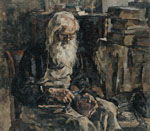
Vissarion - Working Shoemaker. 1926
In the spring of 1927 P.P. Konchalovsky.s studio is unexpectedly visited by a group of Japanese. The artist has been invited to participation at an exhibition of the Soviet art in Japan.
Thus Konchalovsky gets acquainted with the Japanese artist Yabe-San and paints his portrait. And two portraits – Khashimoto and Ikoia – are ordered besides it.
Preparing for the Fourth personal exhibition in the State Historical museum in Moscow, the artist finishes the family portrait begun in 1926 under the name “Misha, bring the beer”.
In the summer of 1927 he goes to Georgia where writes a series of mountain landscapes and the genre products frequently with an epic shade.
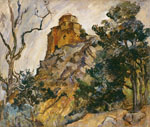
Mtsiri. Storm. 1927
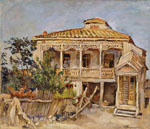
Mtskhet. Sandro-Saklia. 1927
A canvas “The Shoeing of a buffalo” remains as an artistic result of Konchalovsky’s travel across Georgia.
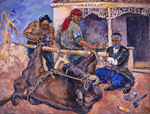
Shoeing of a Buffalo. 1927
In 1928 he goes to Novgorod again. This time landscapes are rare, special attention is paid to the citizens (“The Fish market”, “At Ilmen-lake”).
During his residence in Novgorod, the master opens new in his creativity painting motive – a landscape through the window.
After returning to Moscow creates a portrait of Japanese actor Todzjura Kavarasaki.
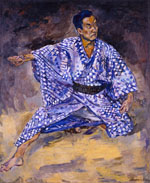
Portrait of Chojuro Kawarasaki, a Japanese Actor. 1928
He works much on the flowers: lilac, blossoming pear, roses, violets, lilies of the valley, orchids, the whole bouquets and even a garden in color.
“It is impossible to write a flower with simple brush-touches, ” so-so “, it should be studied, and deeply, as well as any thing else. Flowers are great teachers of artists: to understand completely a structure of a rose, it is necessary to work not less, than at studying a human face. There is everything in the flowers, that exists in the nature, though in more refined and complex forms, and it is necessary to make researches in each flower, and especially in a lilac or a bouquet of wild flowers, as in a whole wood thicket till you’ll be able to catch the logic of construction, deduce the laws of the combinations seeming casual… I write them as the musician plays his scales. After two hours of steady work something turns inside my mind and flowers become changed into sounds somehow… It is the grandest exercise for each painter “.
By Nikolsky …1936, p.112
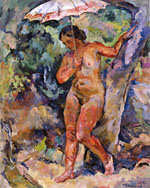
Girl under the Umbrella. 1929
In 1929 Konchalovsky writes a series of winter city landscapes.
In the summer of the same year he works in Crimea (Balaklava, Gurzuf),
writes such works, as “The Balcony with Grapes”,”Grapes on a Plate”, “Leaves of Tobacco”.
The artist estimates the trips to Caucasus and to Crimea, as the greatest events of his creative life for last years. He works much with water colors, aspiring to simplicity and ease of composition, tries to paint in oils, simulating water color techniques and opens in it the new textural opportunities.
“Having taken from the nature a casual to turn it into regular, – it is the original law of a composition in painting. We cannot search for a composition, sitting at home and running in fury around the room as Cezanne did when trying to put his still-lives. We are off from such way. We need to snatch out that string which leads to an original composition from the alive, untouched nature, it is necessary to accustom the eye to take at the first sight only that is necessary, from all heap of opportunities.. “
By Nikolsky …1936, p.113
At the same time the artist writes many still-lives among which the “still-lives of smoking accessories” prevail: the images of pipes, tobacco boxes, ashtrays, leaves of tobacco.
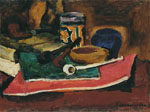
Still-Life. Pink Notebook and Pipes. 1929